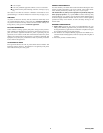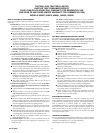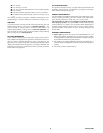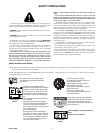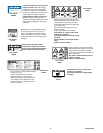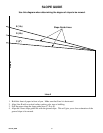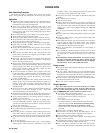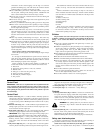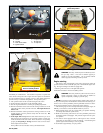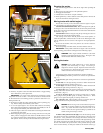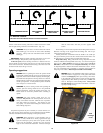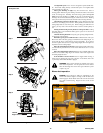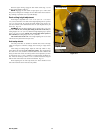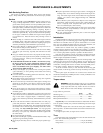
12 601156_0308
of hazards to avoid a wheel dropping over the edge or to avoid the
ground from breaking away. This will reduce the risk of the machine
suddenly rolling over causing serious injury or death.
▲ Use a walk behind, push mower or hand-held trimmer on slopes and
near drop-offs, retaining walls, drainage ditches, embankments and
water to avoid machine rollover and serious injury or death.
▲ Do not mow on wet grass. Reduced traction could cause sliding and
loss of steering control.
▲ Do not tow on slopes. The weight of the towed equipment may cause
loss of traction and control.
▲ Do not try to stabilize the machine by putting your foot on the ground.
▲ If the mower’s tires lose traction when operating on slopes, disengage
the blades, place the steering control levers in the park brake position,
turn the engine off and get help.
▲ Never make sudden starts, stops, turns, or reverse direction, especially
when maneuvering on slopes. The steering is designed for sensitive
response. Rapid movement of the steering control levers in either
direction could result in a reaction of the tractor that can cause serious
injury.
▲ Never stop suddenly while backing down slopes. This action may
result in a reaction of the tractor that can cause serious physical injury.
▲ The Hustler mower is capable of operating horizontally (traverse) on
moderately steep slopes. When operating on slopes up to 15 degrees,
be aware of any conditions that may cause the tractor drive tires to
lose traction resulting in a possible loss of control of the machine. An
operator should not operate on a slope until he is thoroughly familiar
with the equipment.
Do not operate on slopes greater than 15 degrees.
Refer to Slope Guide, page 9, when determining the degree of slope
to be mowed.
It is strongly recommended that the operator drive the machine off
of the slope, using extreme caution, if any sign of loss of traction is
detected. Wait until the condition that caused the problem is resolved
before attempting to operate on the slope again.
Terrain conditions can affect traction resulting in possible loss of
control of the machine. Some of the conditions to be aware of are:
1. Wet terrain
2. Depressions in the ground; i.e. holes, ruts, washouts
3. Mounds of dirt
4. Soil type; i.e. sand, loose dirt, gravel, clay
5. Grass type, density, and height
6. Extremely dry conditions of grass
7. Tire pressure
The attachments mounted to the tractor will also affect the way it
handles on a slope. Be aware that each attachment’s characteristics
vary.
Another consideration to safe mowing on slopes is to be aware of
what is located at the bottom of the slope. Extreme caution should be
used when there is a hazard located at the bottom of the slope. Some
examples are:
1. Water; i.e. lake, river
2. Cliffs, retaining walls
3. Roads, highways
4. Buildings
5. Rocks
These are just a few examples of situations when caution must be
used when operating on a slope. There are many other possibilities
too numerous to mention. Just remember to always exercise extreme
caution when operating on any slope.
Children
Tragic accidents can occur if the operator is not alert to the presence
of children. Children are often attracted to the machine and the mowing
activity. Never assume that children will remain where you last saw
them.
▲ Never leave machine unattended with ignition key in switch, espe-
cially with children present.
▲ Children or bystanders may be injured if they move or attempt to oper-
ate the tractor while it is unattended. Always disengage deck clutch,
place steering control levers in park brake position, stop tractor
engine, and remove ignition key when leaving operator’s seat.
▲ Keep children out of the mowing area and under the watchful care of a
responsible adult other than the operator.
▲ Be alert and turn the machine off if children enter the area.
▲ Before and while backing, look behind and down for small children.
▲ Never carry children, even with the blades off. They may fall off and
be seriously injured or interfere with safe machine operation. Chil-
dren who have been given rides in the past may suddenly appear in the
mowing area for another ride and be run over or backed over by the
machine.
▲ Never allow children to operate the machine.
▲ Use care when approaching blind corners, shrubs, trees, the end of a
fence or other objects that may obscure vision.
▲ Never allow children or others in or on towed equipment.
Control Panel
IMPORTANT: When access is required under the seat platform and the
seat is equipped with the optional arm rests, make certain to place the
control arms in the park brake position and pivot the arm rests upward
before placing the seat platform in the full forward position to prevent
arm rest damage.
Control Panel
A. Choke control (Fig. 3-1) — a cable is linked to manually operate the
engine choke. When the control knob is in the down position, the choke
is in the off (run) position. When the control knob is pulled up, the choke
is in the on (start) position. Do not operate the machine in the on (start)
position.
B. Throttle control (Fig. 3-1) — a cable is linked to engine throttle for con-
trolling engine speed. Move lever forward to increase engine rpm, move
lever rearward to decrease engine rpm.
C. Deck clutch switch (Fig. 3-1) — this switch engages the deck. Pull the
switch up to engage and push switch down to disengage the clutch.
IMPORTANT: Never engage clutch with engine running at high rpm or
when the deck is under load. Clutch, belts or deck could be damaged.
D. Ignition switch (Fig. 3-1) — a three position switch: off, run, and start.
With key inserted, rotate it clockwise to START position; release key
when engine starts, and switch will automatically return to the RUN
position.
E. Oil pressure light (Fig. 3-1) — this light comes on when the ignition
switch is placed in the RUN position and stays lit until the engine is run-
ning and a safe oil pressure is developed. If light comes on during oper-
ation, shut engine off immediately and locate and correct the problem.
F. 20 amp fuse (Fig. 3-1) — Main - 20 amp, blade-type
G. 10 amp fuse (Fig. 3-1) — Clutch/Aux - 10 amp, blade-type
Controls
A. Steering control levers (Fig. 3-2 & 3-3) — these levers control the trac-
tor’s speed, direction, stopping, neutral lock, and park brake. Levers are
used to steer, accelerate, decelerate, stop and change direction. When the
control levers are in the park brake position (3-3) the tractor will not
move when the engine is on and drive pumps are operating.
WARNING: The parking brake may not hold the tractor if
parked on a slope. Block or chock the machine when parked
on a slope
B. Deck lift pedal (Fig. 3-4) — the deck lift pedal is used to raise or lower
the deck. Push on the pedal to raise the deck and then place the deck
height locking pin into the desired cutting height hole.
Push the deck lift pedal to raise the deck when going over obstructions.
Safety start interlock system
The tractor is equipped with a safety start interlock system consisting of
the park brake switches, seat switch, and deck clutch switch.
Check tractor safety start interlock system daily, prior to operation.
This system is an important tractor safety feature. It should be repaired



